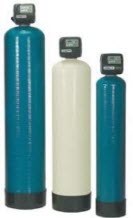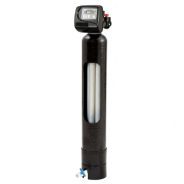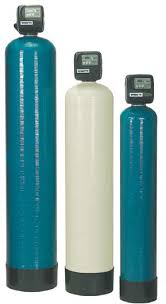
What Are Backwashing Filters?
Whole house backwashing filters are the most common point-of-entry (POE) systems sold today. They are popular because they can be customized for various application just be manipulating the media(s) that are contained inside the vessel or tank. Backwash filter systems are tank-style filters that are capable of self-cleaning by reversing the water flow internally (backwashing) to remove captured contaminants. An electronic control valve controls this flow of water and are programable to backwash on certain days, pressure changes, or volume of water that has passed through the system. They can also utilize a downward flow or upward flow set-up depending on the media utilized.
Generally, one or more types of granular filtration media(s) such as sand, anthracite, carbon, or other minerals are utilized inside the filter tank. Thus, they are sometimes referred to as a mineral tank. The huge advantage of backwashing filters over traditional cartridge or bag filters is the latter two require manual cleaning or replacement. Manual cleaning can be an inconvenience especially in cold or bad weather conditions. A backwashing filter is more of a hands off approach that requires very little maintenance over the course of several years.
Backwashing filters are better designed for applications where pressure drop due to effluent turbidity is expected and cannot be tolerated. Backwashing water treatment systems trigger the reverse flow after specific time laps or pressure changes in order to avoid filter clogging. These filters are suited for the removal of different types of impurities; however, the filtration media differ according to applications.
There are different types of filtration medias that are used for backwash water filters applications. Some popular filtration medias used in backwashing water filters are Pyrolox, Birm, Calcite, Manganese Greensand, and Micro Z.
Let us go through the types of filtration media used in the backwashing system and the contaminants they can remove.
What Are the Types of Filtration Media in Backwashing System?
Water contamination can be differentiated into two types – 1) sediment or suspended matter that can be visibly seen and make water cloudy, 2) dissolved minerals and compounds that are in the ionic form that cannot easily be seen with the naked eye. To remove either type of contamination, there are various options of filtration media types that can be utilized. Therefore, the following are types of filtration media used under two filtration categories.
1. Media for Whole House Backwashing Filters to Remove Dissolved Solids
Dissolved solids are the particles below the size of 0.02 microns. The mechanism to remove these micro-contaminants utilize one of two processes: adsorption or absorption. Absorptive media pulls the contaminant inside the media in a similar fashion a dry sponge would adsorb a liquid. Adsorptive media attracts the contaminant, and the contaminant adheres to the surface of the media in a similar fashion a magnet would attract metal flakes. Adsorptive medias usually have a chemically treated surface which acts as a catalyst to change the oxidative state of the contaminant.
The following type of filtration media is used in backwash filter systems for removing micro-contaminants.
Absorptive Media Options
- Granular Activated Carbon (GAC): This filtration media is used for removing chemical contaminants. These activated carbon granules can remove chlorine, chloramine, pesticides, other chemicals and suspended matter. This media is well suited for moderate reduction of odor or foul taste from water.
- Catalytic Carbon: This is carbon-based filtration media that has a catalytic coating. It can address a wide range of chemicals and pesticides like GAC and it specifically used for chloramine removal and hydrogen sulfide reduction in drinking water. This media fall under the umbrella of expensive yet effective filtration media in backwashing filters.
- Bone Char Carbon: Bone char is a filtration medium used for fluoride removal. It consists of bone char of old animals, which possess a carbon surface and hydroxyapatite lattice surface. Therefore, it has calcium and carbon, which helps in fluoride reduction by interchanging OH–
Absorptive Media Options
- Birm: Birm is a filtration media comprised of aluminum silicate and impregnated with manganous salts. It works well for iron reduction; however, the water’s pH must be maintained at a pH of 6.8 or above for it to be effective. It is light in weight which is advantageous for applications with lower flow rates such as a private well. Hydrogen sulfide, chlorine, and ozone can attack the media and other options would need to be considered if these contaminants are present.
- Manganese Greensand or Greensand Plus: Greensand is siliceous mineral called glauconite coated with manganese oxide. To assist in the oxidation of metals, potassium permanganate is used during the regeneration cycle clean and activate the catalytic surface. Greensand Plus would use chlorine for the regeneration cycle or fed continuously into the incoming water stream of this backwashing filter system. It is effective for iron removal can reduce manganese and hydrogen sulfide.
- Pyrolox, Filox, Katalox: This class of media is fully comprised of manganese oxide and is therefore a more effective filtration media for iron, manganese, and hydrogen sulfide removal. It is a heavy mineral, which requires much higher flow rates for backwashing cycles that some private wells cannot accommodate. The cost of this media is more expensive than the medias listed above.
2. Media for Sediment Backwash Systems to Remove Sediment Contamination
Following filtration media are used for the removal of solid sediments in a whole house sediment backwashing system.
- FilterAG: FilterAg and sand is a silica mineral that is a cost-effective option for the removal of sediment and debris. It is the least expensive and the most widely available of all water filtration medias.
- Anthracite: Anthracite is a hard coal with few impurities which makes it ideal for water filtration. It is often used as multi-media filtration includes layers of garnet, sand, and anthracite. These multiple layers are effective in the reduction of small and large particles. These are used for the filtration of solid impurities, marine sediments, sand granules, and oxidized iron particles.
- Zeolite or Micro Z: These media are used for micro-sediment extraction of sizes between 2 to 20 microns. These products have a longer useful life than the sediment medias mentioned above while retaining its filtration capabilities. The sediment filtration efficiency of these media is excellent, therefore is used for effective water purification processes. The surface is easily manipulated and allows for modified zeolites to address the removal of specific contaminants.
Honorable Mentions:
- Calcite, Corosex, FloMag: Calcite is comprised of calcium carbonate and is a sacrificial or consumable type of media used for increasing the pH of acidic water. It slowly dissolves in water releasing naturally occurring calcium carbonate which increases the pH. It must be refilled or replenished periodically as it dissolves. Corosex and FlowMag are magnesium oxide medias used in conjunction with Calcite or used alone for water with a very low pH. These medias are normally used in non-backwashing filters; however, the media can fuse together if not agitated and a backwash cycle would prevent this occurrence.
How do Backwashing Filters work?
The working of the backwash water filters is generally differentiated into two stages. The first one is a forward or service water filtration. The second stage is backflush or waste removal. The overall working of backwashing filters takes place in the following steps.
1. Forward Water Filtration
- In the forward filtration, the source water enters a port located on the back side of an electronic valve. This valve located at the top end of the vertical filtration tank. The water flows down through the filtration media which surrounds a riser tube (discussed later).
- As the water passes through filtration media, contaminant particles are entrapped in/on the filtration media to the bottom of the tank.
- Incoming water pressure at the bottom of the tank forces the purified water to travel up the internal riser tube that exits a parallel treated water port on the electronic valve.
- This process is like other filtration processes. However, the various filter medias can be potentially be combined for different contaminants to be filtered out of a single system.
2. Backflush
- The first of three cycles is the backwash cycle. The water flow is opposite of what is described above. The water from the source still enters the same port in the valve. However, the source water flows down through the riser to the bottom of the tank then flows up through the media and lifting the media which releases the captured contaminants. The contaminants and rinse water flows out of a third port on top of the electronic valve. This can be 8 – 12 minutes on average.
- The second cycle is a rapid rinse which resettles the media bed and the travels through same route mentioned during the forward water filtration mentioned above. The exception, the water does not exit through the treated port but instead it flows through the waste port.
- The last cycle is a settling rinse at a low flow rate of approximately 2 minutes. At this point, all contaminants have been removed, the filter media has been cleaned, and the valve is not ready for service.
Note: The backflush or backwash cycle is triggered after a periodic time-lapse of 12 to 20 minutes on average. Many valve have options for a second backwash cycle or a bine/chemical draw in addition to the cycles mentioned above based on the type of filtration medium and impurities to be removed.
Why Is Backwashing Important?
After a specific volume of water is treated, the filtration bed is prone to the accumulation of dirt and impurities. Most of the contaminants accumulate at the top of the bed which is known as filter cake. While smaller impurities work their way down through the bed. This may result in pressure drops or bleed through. As the filter clogs, contaminants can push their way through the entire filter bed and into the intended clean water supply. To avoid such conditions, the use of an automated POE backwashing filter is important. The following are the benefits of self-cleaning cycle that make backwashing important.
- Backwashing acts as a filter rejuvenation process. It helps in removing captured impurities and cleaning the media surface which makes the filter work as new.
- In the case of ultra-filters, it removes infectious contamination from the membranes. Therefore, the chances of infection in the treated water utility sources are reduced.
- It aerates and releases the filtration space in the filter bed, which further helps in reactivating the filtration media. This helps in enhancing filtration efficiency after periodic cycles of use.
- It helps in maintaining the filtered water flow and reduces pressure fluctuations
What Can A Backwash Filter Remove?
The following are some contaminants or impurities that backwashing systems can remove.
- Iron, manganese
- Fluoride, pesticides
- Chlorine, chloramine, trihalomethanes, haloacetic acids
- Hydrogen sulfide
- Odor and foul taste
- Suspended matter, marine sediments
What Are the Types of Backwash Filters Offered By Intec America?
Owing to the utility and demand of backwash filters, Intec America offers the following types of backwashing filters.
- Ultra-Filtration Backwashing Filters: The ultra-filtration backwash filters by Intec America are designed for filtration of micro-contamination and biological concerns down to 0.02 microns in size. This type of backwashing filter uses 4 UF membranes. These are suitable for the reduction of bacteria, viruses, cysts, turbidity, tannins, etc from the water. It offers 12gpm peak rate and is NSF 61 certified.
- Multi-Media Backwashing Filters: These backwash filters are customized by Intec America. Depending on the utility requirements of the end user, these backwash filters are customized for specific load capacities, flow rates, selective contaminant removal, and self-cleaning requirements. There is no limit to the volume of water or flow rates for our customized systems.
Where Are the Backwash Filters Used?
Backwash filter systems are found in domestic as well as industrial applications. The following are commonly known applications of backwash filters.
- City water supply
- Pool cleaning and maintenance
- Domestic whole house water filtration systems
- Hotels, restaurants, resorts, casinos
- Supermarkets and convenience stores
- Well water filtration systems
- Dry cleaners
- Cooling towers
- Livestock operations
- Agricultural irrigation
- Nurseries, greenhouses, and hydroponic systems
- Portable water treatment plants
- Industrial water treatment plants
- Wastewater treatment plants
- Pharmaceutical, mechanical, chemical, food processing, etc.
To gain more information about our backwash filter systems, please get in touch with our experts at Intec America.

Nelsen Poly-UF™ Ultra-filtration
The Enpress Poly-UF™ system offers filtration down to 0.02 micron at service flow rates up to 12gpm. Utilizing ENPRESS’ patented and industry exclusive liner design, the internal UF module treats colloids, bacteria, cysts, viruses, turbidity, tannins, and other particles down to 0.02 micron size. The patented polysulfonebased Outside/In Ultrafiltration Membrane is designed for turbidity, cyst reduction and fine sediment filtration applications, and is NSF 61 certified.



